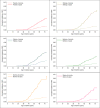Quantification of familial risk of nasopharyngeal carcinoma in a high-incidence area
- PMID: 28241094
- PMCID: PMC5498222
- DOI: 10.1002/cncr.30643
Quantification of familial risk of nasopharyngeal carcinoma in a high-incidence area
Abstract
Background: To the authors' knowledge, no studies to date have explored familial risks of nasopharyngeal carcinoma (NPC) in detail and quantified its lifetime risk in high-incidence populations.
Methods: The authors conducted a population-based case-control study of 2499 NPC cases and 2576 controls randomly selected in southern China from 2010 through 2014. Unconditional logistic regression was used to estimate multivariable-adjusted odds ratios (ORs) with 95% confidence intervals (95% CIs) associated with a family history of NPC. In addition, the authors compiled a reconstructed cohort comprising 40,781 first-degree relatives of cases and controls to calculate the lifetime cumulative risk of NPC.
Results: Individuals with a first-degree family history of NPC were found to be at a >4-fold risk of NPC (OR, 4.6; 95% CI, 3.5-6.1) compared with those without such a history, but had no excess risk of other malignancies. The excess risk was higher for a maternal than a paternal history and was slightly stronger for a sibling compared with a parental history, and for a sororal than a fraternal history. Among relatives of cases, the cumulative risk of NPC up to age 74 years was 3.7% (95% CI, 3.3%-4.2%), whereas that among relatives of controls was 0.9% (95% CI, 0.7%-1.2%). Cumulative risk was higher in siblings than in parents among relatives of cases, whereas no such difference was noted among relatives of controls.
Conclusions: Individuals with a family history of NPC have a substantially higher risk of NPC. These relative and cumulative risk estimates can guide the development of strategies for early detection and clinical consultation in populations with a high incidence of NPC. Cancer 2017;123:2716-25. © 2017 American Cancer Society.
Keywords: case-control study; family history; nasopharyngeal carcinoma (NPC); relative and cumulative risk; southern China.
© 2017 American Cancer Society.
Conflict of interest statement
Figures
References
-
- Chang ET, Adami HO. The enigmatic epidemiology of nasopharyngeal carcinoma. Cancer Epidemiol Biomarkers Prev. 2006;15:1765–1777. - PubMed
-
- Friborg J, Wohlfahrt J, Koch A, Storm H, Olsen OR, Melbye M. Cancer susceptibility in nasopharyngeal carcinoma families–a population-based cohort study. Cancer Res. 2005;65:8567–8572. - PubMed
MeSH terms
Grants and funding
LinkOut - more resources
Full Text Sources
Other Literature Sources


